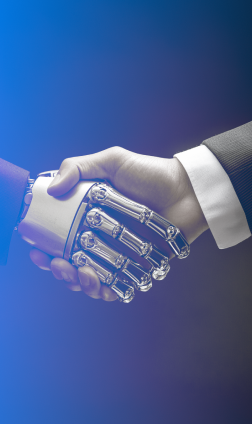Focus on Value and Data Foundations To Make AI Successful
There is growing evidence that financial institutions are finally getting to grips with what Generative AI can do for them, after a lot of hype and experimentation. In fact, 2024 may well be remembered as “the year that started delivering proofs of concepts (PoCs) with Gen AI.”
After ChatGPT was released in late 2022, and gained momentum in 2023, many financial services organizations created teams to rapidly get up to speed with the new technology and apply it to their businesses. Progress is evident, but there is still plenty of work to do and success will only happen if the right foundations are put in place.
As these new capabilities are integrated into real use cases, we believe that 2025 could be remembered as: “The year of delivering business value with Gen AI.” Therefore, as many organizations are entering their annual planning efforts, this is a good time to pause and reflect on what will be needed to deliver that value in 2025 and beyond.
Focused efforts
In some cases, these new efforts focused on large language models (LLMs) and complemented existing AI workstreams in areas such as fraud analytics or customer modeling. In other cases, completely new teams were created to look at all forms of AI, LLMs, machine learning (ML), and data analytics, to tackle a wide range of challenges across the organization.
As these focused teams built up in 2023 and began delivering results in 2024, most were successful in demonstrating they had mastered the core technologies of AI and Gen AI. However, relatively few of these projects were successful in delivering actual value from Gen AI. This may seem disappointing, but it is a natural outcome for a new revolutionary technology. There are parallels with the dot com bubble of the early 2000s, where many early internet companies did not succeed. But their failures laid the groundwork for the tremendous subsequent success of the internet.

Four foundations
We believe near and long-term success with AI will come down to four foundational considerations:
A strong focus on projects that deliver measurable business value
Comprehensive data management
Continued commitment to modernizing core IT infrastructure
Continued support for the AI teams built up over the last couple of years
Focus on Value
Differentiated value
Finally, there will be a set of projects where a custom build will deliver significant, differentiated value. Identifying which efforts fall into these categories and prioritizing them accordingly will not only optimize the value delivered but also ensure your highly specialized AI teams are focused on the best efforts. Other teams can then work on integrating existing AI products.
For LLM-based Gen AI, many recent PoCs show that the real value of the technology rests in use cases that today use large human workforces to perform language-based tasks. These range from working with documents to chatting with customers. However, the most measurable value from Gen AI often comes from reducing the time and headcount needed to perform these tasks.
In some cases, Gen AI may create an opportunity to completely rethink how to complete a task or optimize a business process. Accordingly, we believe that some of the most successful Gen AI projects in 2025 will be those that target these tasks.
In short, a focus on value involves a partnership between technology and the business, matching these highly capable tools to the most pressing issues and valuable opportunities. Partnership is always important, but it is even more so in the world of AI, as everyone is learning how to use, trust, and value the technology.

Data Management for AI
For all the hype around AI and Gen AI, the technology is only as good as the data it has available. The best offer engine in the world cannot work if you don’t have customer data or that data cannot move easily to the engine. Many organizations are learning that data inefficiencies that were once seen as minor issues are now major hindrances to their AI efforts.
This means that focusing on AI requires a focus on data. Making foundational improvements to the way you manage data may not be as exciting as exploring new LLMs, but it is necessary and must be accounted for in planning and budgeting. In 2025, we expect to see many organizations “slow down to speed up” with their AI projects.
Many of the projects of 2024 have shown teams where they have the biggest issues with their data, so they are now ready to prioritize investments in data management. That will ultimately pay off through the AI and Gen AI projects that they facilitate.
Core Modernization for AI
AI projects have rippling effects that go beyond data and into the rest of the core IT systems. AI often requires access to more computing resources or specialized computing resources such as GPUs. In some cases, the volume of data requires new data storage approaches and new networking connectivity, to ensure that massive amounts of data can be moved and used effectively.
For many organizations, this will accelerate efforts to take additional advantage of cloud providers that offer this scalability and flexible access to specialized hardware. In some cases, the AI roadmap will create new considerations for selecting a cloud provider. For instance, different providers offer differentiated access to large GPU clusters, or different cost structures for uploading, storing, and using massive amounts of data.
Similarly, one must not overlook that the cloud providers are also building software platforms that facilitate key AI tasks. These range from core analytics functions to LLM model training and providing read-to-use chatbots, with new features and functionality being added at pace. As a result, AI-focused organizations should be careful to not only accelerate modernization efforts but also ensure that their course is still correct for these new considerations.
Supporting the AI team
The first three considerations were about transitions and continuous improvements to planning processes and technology. This last consideration is focused on the people and the teams that were created to bring the value of AI to the organization.
In 2025 and beyond, these teams will need to transition from ramp-up and skill-building to being a strong enabler of delivering business value. They’ll need to continuously improve as AI and Gen AI technologies continue to advance. To do this, they’ll need continued support and partnership from the rest of the organization.
However, we can also draw parallels to the previous section, which talked about cloud providers as AI partners, providing flexible and scalable access to resources and differentiated services to complement your core. The same can be said about choosing an AI partner for your team — a partner that can provide scalable and flexible human resources when needed and can supply skilled team members as you need them, without the additional overheads of hiring, onboarding, and training.
A strong partner
Looking forward
The recent focus and rapid adoption of AI and Gen AI has not always resulted in business value. But it has delivered valuable learnings about where and how the technology should be used, and where gaps exist in the IT infrastructure. It has also shown how teams of AI experts can work together, with business partners, and with external technology partners.
The most successful organizations of 2025 will be those that put these lessons into action, with value-led project planning, investments in data management, continued adoption of cloud hardware and software, and continued investment in the AI teams that will deliver that value.
We are still in the early days of a longer AI journey where we will see leaders build success upon success, creating smarter, more capable AI and Gen AI solutions over time. SoftServe has proven it can be your partner on that journey, providing guidance and giving you confidence that AI-led projects will deliver the successful outcomes you require.



